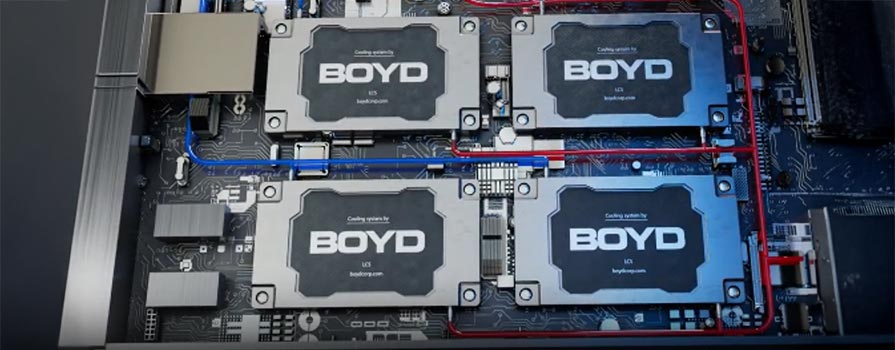Embedded systems are becoming more complex, processing and analyzing a growing number of sensors and signals. The result of this increased computing is often higher and more concentrated electronic heat loads.
How to Design a Liquid Cooling System for High-Performance System Thermal Management
Because excessive heat compromises the reliability of a system, air cooling is no longer adequate for some applications. Many engineers are turning to liquid cooling to remove the heat.
The complexities of designing a liquid cooling system can be intimidating for those unfamiliar with this set of technologies. Although selecting thermal components for a liquid cooling loop is relatively straightforward, there are other considerations or nuances that can be overlooked. These include materials compatibility, corrosion prevention, condensation control, the position of the liquid cooling loop, use of standard versus custom parts, joints, fittings, connectors, and maintenance and service.
A liquid cooling loop typically consists of a liquid cold plate, pump, heat exchanger, and pipes or hoses (Figure 1). The board generates waste heat, which is transferred from the board to the thermally conductive plate, and then to the liquid coolant that flows through the cold plate. Typically, the fluid path matches hot spots on the board. The heated coolant is then pumped through the heat exchanger, where heat is moved from the coolant to either ambient air, or, in the case of a liquid-to-liquid heat exchanger, to another liquid coolant. The cooled coolant then flows through pipes or hoses back to the cold plate, completing the cooling loop. Under normal operation, liquid coolant continuously flows through the liquid cooling loop to keep the board cool.
Material Compatibility
Since all materials and the fluid in the liquid cooling loop need to work together as a system, they need to be compatible with one another and should be selected together. Copper works well for most applications, since it has excellent thermal conductivity and is compatible with most non-corrosive fluids. Aluminum is compatible with fluids such as polyalphaolefin (PAO), oil, ethylene glycol and water solutions (EGW), as well as Fluorinert™, an electrically insulating inert perfluorocarbon fluid manufactured by 3M and used in many electronics cooling applications. Stainless steel is compatible with most fluids, including corrosive fluids such as deionized water. Several different fluids are compatible with various standard cold plate and heat exchanger materials (Figure 2).
Figure 2: Various fluids are compatible with a variety of standard cold plate and heat exchanger materials
Most liquid coolants also need a small percent of additives to inhibit corrosion and to lubricate the pump. However, it is important to note that corrosion inhibitors can be rendered ineffective by incompatible materials elsewhere in the system, so this must be evaluated as well. Biocides, algaecides, and pH adjustments may also be helpful in maintaining your system, depending on which liquid coolant is selected.
| Material & Transfer Fluid Compatibility | Water | EGW | Deionized Water | Oil | Dielectric Fluids (ex. Fluorinert™) | Polyalphaolefin (PAO) |
|---|---|---|---|---|---|---|
| Copper Tubing | X | X | ||||
| Stainless Steel Tubing | X | X | X | |||
| Aluminum Flat Tube or Plate-Fin | X | X | X | X | ||
| Copper Flat, Copper-Etched, or Copper-Brazed | X | X | X | X | X | |
| Machining | X |
Corrosion Prevention
Corrosion can cause problems two different ways. Not only can material corrode away, which leads to leaks, but the corroded material can be deposited elsewhere in the system and block fluid passages or filters. This can produce a pressure drop that causes reduced coolant flow. In addition, if the deposition occurs on active heat transfer surfaces, the extra thermal resistance caused by fouling can make temperatures rise.
Both galvanic corrosion and erosion-corrosion should be minimized in the liquid cooling loop. Galvanic corrosion occurs when dissimilar metals are in electrical contact with each other in the presence of an electrolyte such as a conductive liquid. Most water-based coolants are electrolytic to some degree. To prevent galvanic corrosion, either the loop should be designed with similar materials throughout the system, ideally with just one metal, or a non-conductive fluid should be used. The galvanic potentials of all materials in the system should be considered. This includes not only the primary thermal components, but also all connectors, fittings, valves, and junctions in the fluid path.
Erosion-corrosion is the acceleration in the rate of corrosion in metal due to the relative motion of a fluid and a metal surface. It is most often found in pipe bends & elbows, tube constrictions, and other structures that alter flow direction or velocity. Erosion-corrosion is most prevalent in soft alloys, such as copper and aluminum.
Some methods for minimizing erosion-corrosion include allowing bends to have larger angles, changing pipe diameters gradually rather than abruptly, and improving flow lines within the pipe by deburring, i.e., smoothing out irregularities. Other methods include reducing the amount of dissolved oxygen, changing the pH, and switching the pipe material to a different metal or alloy. See our application notes “Erosion-Corrosion in Cooling Systems” and “Avoiding Galvanic Corrosion” for more information on corrosion.
Condensation and Liquid Cooling Loop Design
In addition to minimizing corrosion, it’s important to minimize or prevent condensation. One of the risks of using coolants below ambient temperatures is that condensation may form on cool surfaces. This condensation can drip onto electronics or collect in the bottom of the system and cause corrosion. To avoid condensation, surface temperature can be maintained above the ambient dew point by either insulating these surfaces or using higher fluid temperatures. Boyd offers a variety of insulating materials like SOLIMIDE® Foam to maintain line temperatures and prevent condensation and potential damage.
In a properly designed and maintained liquid cooling loop, leaks are very unlikely. However, to minimize the effect of any potential leaks, the reservoir and liquid loop can be located below electronics that would short out if coolant or condensate dripped or sprayed on them. Other options include installing a liquid shield or barrier over the high-voltage portions of the electrical system.
When designing the liquid cooling loop, there is also the option of using standard or custom parts. There are advantages and disadvantages to each. Standards are readily available if replacements are needed. Custom parts, on the other hand, are optimized for the application’s size, performance, and device requirements. However, they will have longer lead times and may have a higher cost.
Joints, Fittings, and Connectors
The number of joints in the cold plate or heat exchanger is important. When there are more joints that must be brazed, there is a higher risk of leaks. It is important to ensure that the manufacturer is highly skilled at brazing, has proper test procedures in place, and eliminates any unnecessary braze points within a custom component.
To prevent leaks, the right fittings must be selected and properly used. For a leak-free joint, a beaded tube fitting mates with a hose that is secured with a clamp. Hard plumbing is generally preferable to hoses, but hoses may be used in environments where systems are exposed to shock or vibration. A unit with a straight tube fitting can be welded into the system or used with a self-locking, torque-free fitting. With a quick-disconnect coupler that isn’t drip-free, you’ll need to expect the occasional drop of fluid when connecting or disconnecting the fittings. For more information, please review our application note on “Choosing a Quick Disconnect Coupler”.
Another option is to use O-rings fittings that are manufactured to Society of Automotive Engineers (SAE) material specifications or those manufactured to military specifications. These fittings are available in various materials and sizes and provide a reliable leak-free seal. Boyd’s O-Ring portfolio and expertise can help ensure you select the right material, certifications, and size quickly to help prevent leaks within your system.
Maintenance and Service
Although maintenance and service may be the last thing engineers consider when designing a liquid cooling loop, including this consideration in the design process will help to reduce problems over the long term. Several different types of questions must be answered.
For example:
- Will the pump need lubrication over its life or is the coolant going to perform that function?
- Will the fluid reservoir need topping off?
- Which components are field-replaceable?
- What is the maintenance schedule?
- What is the required pump life?
- If pump replacement is needed, how does one charge the system and start the system up?
Other questions concern what the user must do to get the system working again.
- Does this require removing the electronics and cold plate, or just the electronics, and can both be easily removed and replaced merely by snapping in a new one?
- If the cold plate is replaced, will it be shipped with cooling fluid?
- Does the OEM ship the system or field-replaceable unit filled with fluid?
- If so, freezing of the fluid may be a concern, such as in aircraft cargo holds that get very cold.
These questions must be considered by members of both design, operations and maintenance teams. Involving all affected individuals in the decision will help to ensure smooth operations in the future.
Materials compatibility, corrosion prevention, condensation control, the position of the liquid cooling loop, standard versus custom parts, joints, fittings, connectors, hoses, and maintenance and service requirements all must be considered when designing either a modified standard or custom liquid cooling loop. When properly integrated into a system, liquid cooling can provide highly effective heat removal with low risk. Today, tens of thousands of cold plates and heat exchangers are liquid cooling electronics in some of the most demanding and high-performance applications.
Written by Richard Goldman and Tracey Barber
Original Published in RTC magazine, July 2006
Visit our Liquid Heat Exchanger Section or Liquid Cooling System Section to learn more about Boyd’s full liquid loop solutions.






